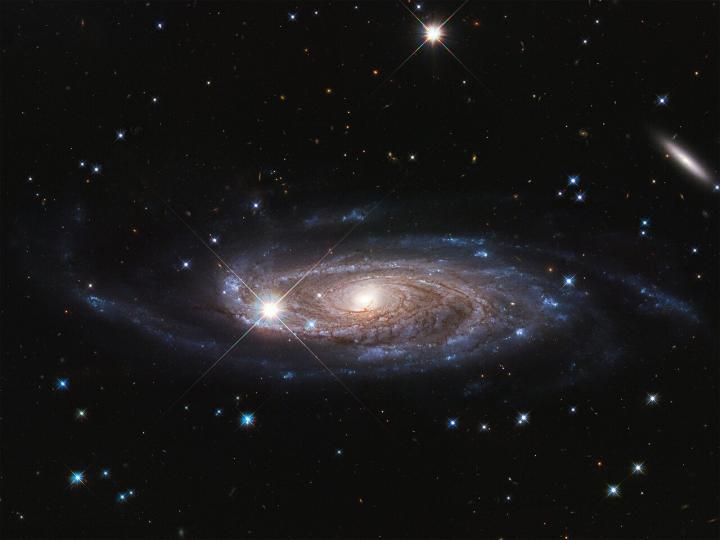
Credit: NASA, ESA, and B. Holwerda (University of Louisville).
To kickstart the 30th anniversary year of the NASA/ESA Hubble Space Telescope, Hubble has imaged a majestic spiral galaxy. Galaxy UGC 2885 may be the largest known in the local universe. It is 2.5 times wider than our Milky Way and contains 10 times as many stars.
Despite its gargantuan size, researchers are calling it a “gentle giant” because it looks as if it has been sitting quietly over billions of years, possibly sipping hydrogen from the filamentary structure of intergalactic space. This is fuelling modest ongoing star birth at a rate half that of our Milky Way. In fact, its supermassive central black hole is also a sleeping giant; because the galaxy does not appear to be feeding on much smaller satellite galaxies, it is starved of infalling gas.
A number of foreground stars in our Milky Way can be seen in the image, identified by their diffraction spikes. The brightest appears to sit on top of the galaxy’s disc, though UGC 2885 is really 232 million light-years farther away. The giant galaxy is located in the northern constellation Perseus.
The galaxy has also been nicknamed “Rubin’s galaxy”, after astronomer Vera Rubin (1928-2016), by Benne Holwerda of the University of Louisville, Kentucky, who observed the galaxy with the Hubble Space Telescope.
“My research was in large part inspired by Vera Rubin’s work in 1980 on the size of this galaxy,” said Holwerda. Rubin measured the galaxy’s rotation, providing evidence for dark matter that makes up most of the galaxy’s mass. “We consider this a commemorative image. The goal of citing Dr. Rubin in our observation was very much part of our original Hubble proposal.”
Researchers are still seeking to understand what led to the galaxy’s monstrous size. “It’s as big as you can make a disk galaxy without hitting anything else in space,” added Holwerda.
One clue is that the galaxy is fairly isolated in space and doesn’t have any nearby galaxies to crash into and disrupt the shape of its disc.
Did the monster galaxy gobble up much smaller satellite galaxies over time? Or did it just slowly accrete gas to make new stars? “It seems like it’s been puttering along, slowly growing,” Holwerda said. Using Hubble’s exceptional resolution, his team is counting the number of globular star clusters in the galaxy’s halo — a vast shell of faint stars surrounding the galaxy. An excess of clusters would yield evidence that they were captured from smaller infalling galaxies over many billions of years.
The upcoming NASA/ESA/CSA James Webb Space Telescope could be used to explore the centre of this galaxy as well as the globular cluster population. The infrared capability of this telescope will give researchers a less impeded view of the underlying stellar populations that will complement Hubble’s visible-light ability to track wispy star formation throughout the galaxy.
###
More information
The Hubble Space Telescope is a project of international cooperation between ESA and NASA.
Image credit: NASA, ESA, and B. Holwerda (University of Louisville)
Links
- Images of Hubble – http://www.
spacetelescope. org/ images/ archive/ category/ spacecraft/ - Hubblesite release – https:/
/ media. stsci. edu/ preview/ news_release/ news/ 2020-01
Contacts
Benne Holwerda
University of Louisville
Louisville, Kentucky, United States
Email: [email protected]
Bethany Downer
ESA/Hubble, Public Information Officer
Garching, Germany
Email: [email protected]
Media Contact
Bethany Downer
[email protected]
Original Source
https:/




